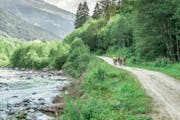Graubünden Tourism
A gravel bike helps you cross fields and forests as quickly as tarmacked roads. We’ve put together the key tips for planning your tour well here – so you can enjoy a safe ride.
When you’re on your gravel bike, you can cover great distances at quite some pace, all while enjoying breathtaking landscapes. We’ve put together the following key tips to help you stay on track, avoid nasty surprises and plan your route well.
Tips for planning a tour

Planning the routes
Forest paths and gravel roads are the best terrain for your tour, so lots of mountain bike routes are also perfect for a gravel bike tour. You can find countless routes on SwitzerlandMobility or Komoot. My tip: you’ll get a better sense of the route if you look at the map in satellite view.

Reserve transport for your bike
Gravel bikes are perfect for taking on the train, thanks to their light weight and narrow handlebars. This means you can get to your tour’s starting-point with ease, or hop on a train to skip less appealing sections of your planned route. In summer, in particular, pay heed to capacity limitations and regulations when making your reservation. You can easily purchase a ticket for your bike and reservation via an app. When transporting your bike, a bike cover is a smart choice.

Comply with traffic blocks
Crossing an Alpine pass is a thrilling experience on your gravel bike, too. But you’re looking to enjoy your adventure without any motor vehicles nearby, right? Some passes are fully or partially car-free, such as the Pragelpass, Kunkelspass or the Grosse Scheidegg between Grindelwald and Meiringen. Pick a time when there’s little traffic on the road, as this will make it much more enjoyable for you.

Switch to forest tracks to avoid passes
You can avoid lots of smaller passes in the Alpine foothills by switching to forest tracks, most of which run parallel to the pass. This enables you to avoid traffic and lets you mainly cycle on gravel, rather than tarmac. These include the mountain bike or cycling routes over the Sattelegg, the Ibergegg (via Alpthal, Brunni, Alp Zwäcken) or the Brünigpass. Use the app Komoot to help you plan your route.

Minimise weight
Want to make good headway without being weighed down? If so, plan to spend the night in youth hostels or mountain huts so you can leave your tent, sleeping bag and sleeping mat at home and trim the amount of weight you’re carrying. You might also have an SAC hut on your route, such as the Maighelshütte hut on the Oberalppass pass or the Monte Bar hut above Lugano.

Basic equipment
While you want to avoid carrying unnecessary weight, you do need to have the right equipment – which has to include a repair kit, a replacement tube and a light. Your mobile, wallet and keys are best stored in your cockpit bag, while your windproof jacket and food should go in your upper-tube bag. Anything else should be stowed in your saddle bag. This ensures you’ll have everything you need at your fingertips at all times.

Less traction
Safety first: when you’re riding on gravel roads, less of your power is transferred than you might be used to on a road bike or a mountain bike. When you’re heading uphill, that means you shouldn’t get out of the saddle too soon and should avoid pushing the pedals too aggressively. Err on the side of caution on bumpy descents and, when you’re on gravel paths, keep an eye out for large stones that could knock your front wheel at an angle. It helps if you keep your arms loose so you can react to uneven terrain.
Equipment for your gravel tour
Share the articleThe right way to plan your gravel bike tour – seven key tips
- Free shipping from CHF 99
(With the TransaCard always free of charge)
- Secure payment with Twint, Visa and more
- 14 days cancellation right








